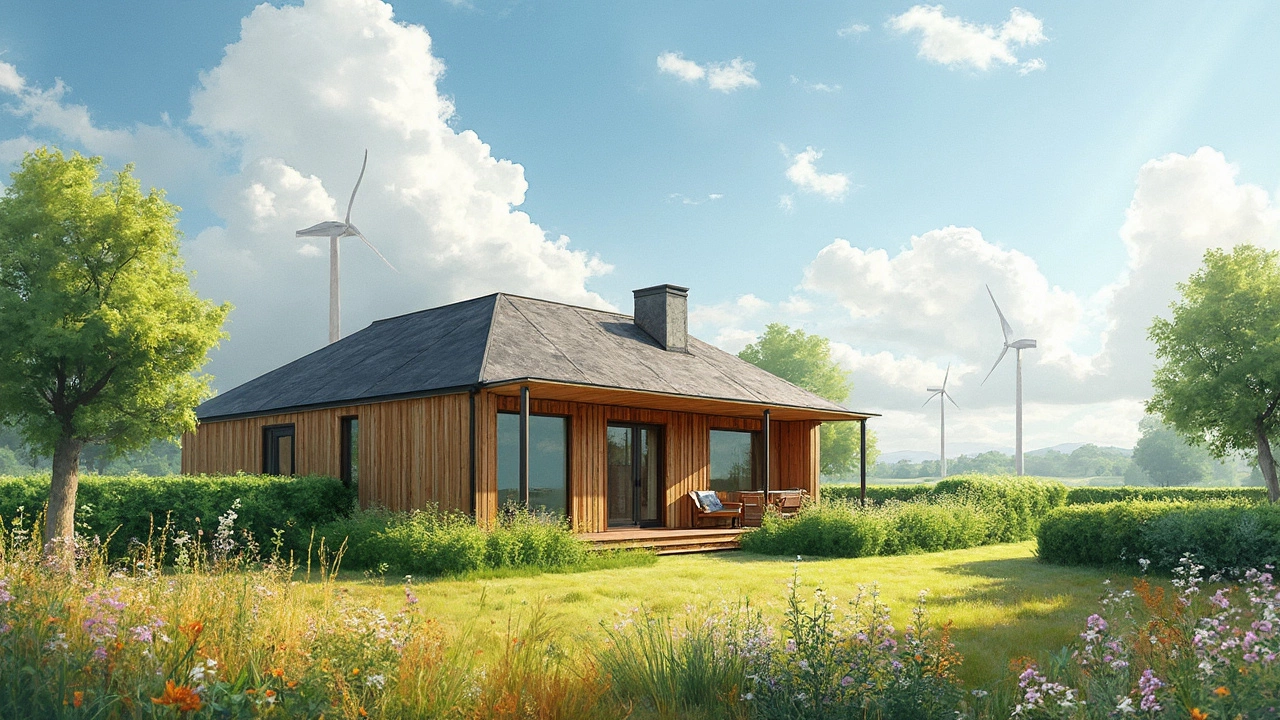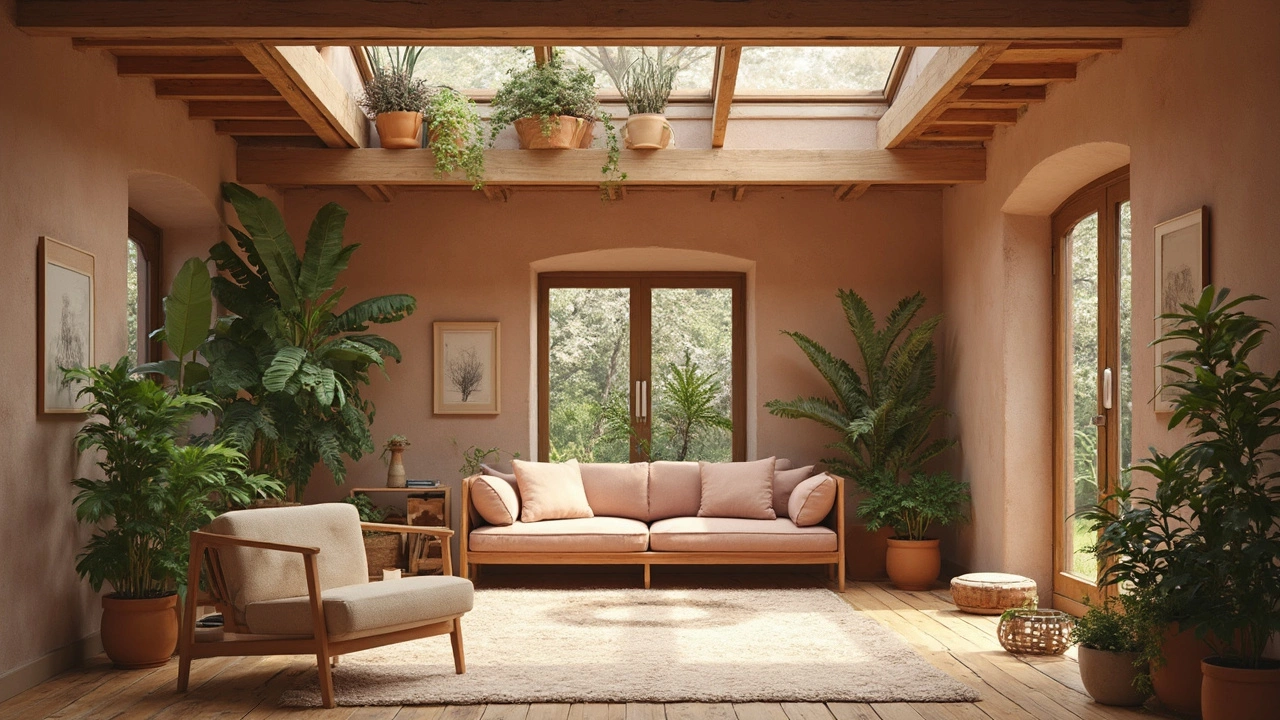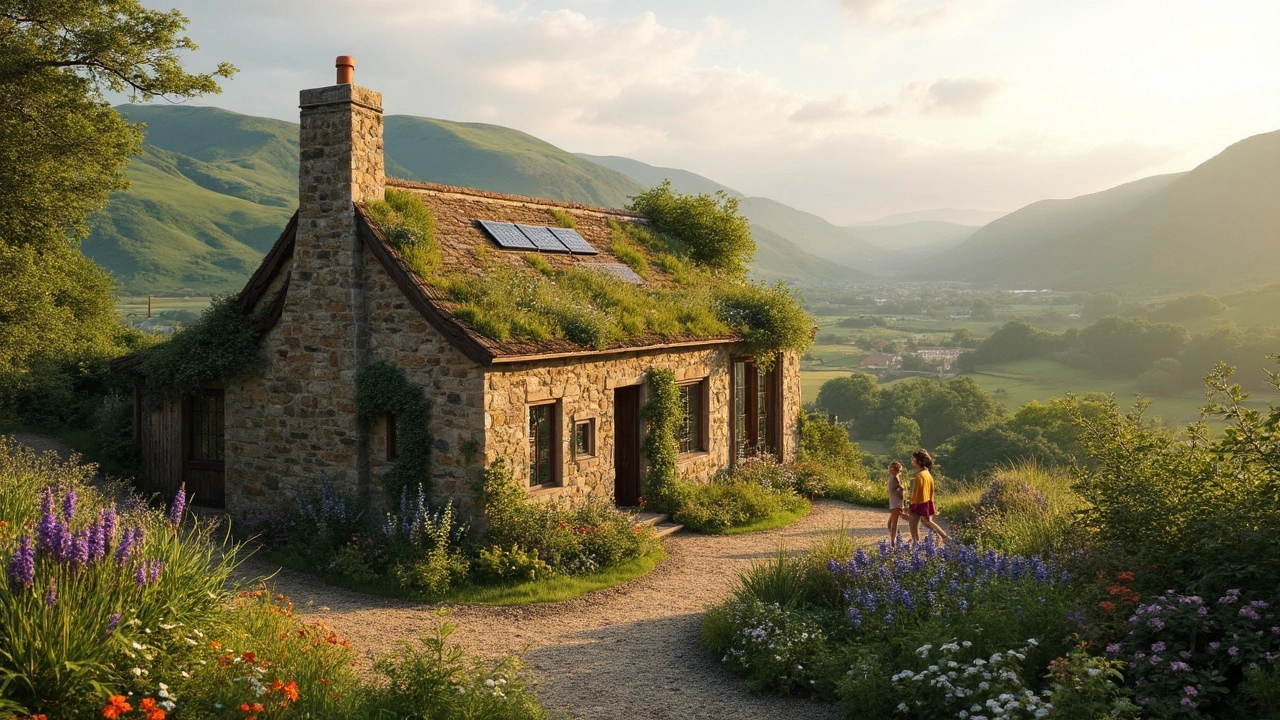If you want a home that does much less harm to the planet, you’ve probably wondered where to even start. Should you be looking at solar panels, or does the type of wood matter more? The truth is, there’s no single answer—making a house truly green comes from looking at the big picture.
Eco-friendly cottages really take off when you mix smart design, natural materials, and the right spot. Traditional building usually pumps out plenty of carbon, chews up energy, and leaves a big mess. But it doesn’t have to work that way. From straw bale to recycled steel, and from tiny houses to solar-powered hideaways, real people are already trying fresh approaches—and you can do the same.
Ready to find out what to actually look for when picking plans and materials? Think about insulation, waste, local resources, and how your house will use (and maybe even make) its own power. Small choices, like skipping plastic or using reclaimed wood from an old barn, really add up over time. Stick around—I’ll show how to spot what matters most, what’s just greenwashing, and how to build or update your own eco-friendly cottage without blowing the budget.
- What Does Eco-Friendly Really Mean?
- Best Building Materials for the Planet
- Design Choices That Save Energy
- Water and Waste: Smarter Living
- Real-Life Cottages and Take-Home Advice
What Does Eco-Friendly Really Mean?
People throw around the term “eco-friendly” all the time, but what does it actually mean when you’re talking about building a house? At the core, it’s about making choices that do the least damage to the environment through every stage—starting with how stuff is made, how it’s shipped, put together, and lived in.
If you care about eco-friendly cottages, you want your home to use fewer resources, create less waste, and work in harmony with nature. That covers a lot, including:
- Choosing local or recycled materials so you’re not racking up carbon miles or using up resources from halfway across the world
- Cutting down on energy use, which means less pollution and lower bills
- Minimizing waste by building exactly what you need and reusing materials whenever you can
- Protecting the local environment, like making sure your home doesn’t destroy native plants or mess with wildlife
- Designing for long-term living, so your house lasts and delivers real value for years instead of heading to a landfill after a decade or two
There’s a big difference between homes that just pay lip service to “green” living (think fancy eco-labels for plastic products) and homes that genuinely work for the planet. Look for the full story—what materials went in, how energy efficient it is, and if it’ll keep working for your family and the earth way down the road.
For a quick look at how homes impact the environment, here’s a snapshot of some stats from recent industry reports:
| Factor | Traditional House | Eco-Friendly Cottage |
|---|---|---|
| Average CO2 Emissions (tons/year) | 8-12 | 2-4 |
| Water Usage (liters/day) | 400 | 150-200 |
| Construction Waste (tons) | 7-10 | 2-4 |
| Energy Used for Heating/Cooling | High | Low—depends on design/materials |
The numbers say it all. Building green isn’t just a bragging right; it can seriously cut pollution and save you a bunch of money long-term. So, when someone asks “what does eco-friendly really mean?”—think smaller impact on every front, from material choices to the way you live inside those walls.
Best Building Materials for the Planet
If eco-friendly cottages top your dream list, picking the right materials is where you can make the biggest difference. Turns out, what you build with is just as important as how you build. Lowering your home's footprint starts way before the first nail goes in.
Here’s what actually matters: look for stuff that’s natural, local, renewable, or recycled. The idea is to cut the carbon cost of shipping and heavy processing, while keeping toxins out of your walls and soil.
- Eco-friendly cottages often use straw bales for walls. Straw is cheap, grows back every year, and makes super-insulated walls that keep heating and cooling bills down. It can even help trap carbon long-term—as long as you keep it dry and well-built.
- Bamboo is another hero. It regrows in a few years, so it beats hardwoods that take decades to replace. It’s strong and looks great, too.
- Reclaimed wood is popular because it keeps old lumber out of dumps. Plus, each board has history—think barns, schools, and factories. Using it means less logging and less energy, since there’s no need to create new boards from scratch.
- Recycled steel might surprise you, but it’s perfect for roofing or framing. Steel takes lots of energy to make the first time, but using recycled scrap drops the environmental cost by up to 75%.
- For insulation, sheep’s wool and cellulose made from old newspapers work better than fiberglass and don’t give off nasty chemicals. They also break down harmlessly if you ever remodel.
Not sure who to trust? The nonprofit BuildingGreen says,
“There’s no single perfect green material—what matters is using the least resources to get the job done for a long time. Durability, low energy use, and safe ingredients should be your go-to checklist.”
One tip: skip concrete when you can. Regular concrete cranks out a ton of CO₂, but there’s new research into low-carbon versions made with less cement or even plant-based binders.
If you have local sawmills or suppliers, call them up—they might have leftover cuts or storm-fallen timber that’s cheap and better for the planet. Every bit you reuse or reshare gets you closer to a real sustainable build, rather than something that just looks green on the outside.

Design Choices That Save Energy
The way you plan and build your cottage can cut your energy use by half, or even more. The secret’s all in the layout, windows, insulation, and how smart you are about letting in (or blocking out) the sun. Most people don’t realize that up to 40% of a home’s energy goes into just keeping it at a comfortable temperature. So, nailing these basic design choices pays off for years.
- Orientation: Position your cottage so big windows face south (in the Northern Hemisphere). You grab free heat from the sun in winter, lowering your need for artificial heat.
- Windows matter: Choose triple-glazed or double-pane windows to keep warm air in and cold air out. Drafty old windows can lose 25-30% of heat!
- Super thick insulation: Natural options like sheep’s wool or recycled denim work as well as or better than fiberglass, without the chemicals.
- Compact design: The fewer corners, bumps, and bay windows, the less energy escapes. Simple, boxy cottages are way easier to keep warm or cool.
- Use thermal mass: Thick walls made from materials like cob or rammed earth absorb heat by day and release it at night, keeping things comfy without added energy.
Don’t let all that planning go to waste by letting air leak out. It’s wild: the U.S. Department of Energy says sealing up leaks and adding decent insulation can chop your heating and cooling bills by 20%.
| Energy-Saving Feature | Potential Annual Savings (%) |
|---|---|
| Triple-glazed windows | 10-15% |
| High-quality insulation | 15-20% |
| Passive solar design | 20-30% |
| Compact layout | Up to 10% |
Finally, try not to make your life too complicated with high-tech stuff you’ll never use. Focus on design choices that just quietly lower your bills, like installing thick curtains or using earth berms to shield one side of your house from wind. You’ll thank yourself every month. And remember, every bit you save on energy means you’re living in a truly eco-friendly cottage.
Water and Waste: Smarter Living
Getting water use and waste management right is a huge part of making your eco-friendly cottage work. It’s not just about fancy gadgets—it’s about everyday habits and simple setups that do a lot of good for you and the planet. If you’re aiming for the lowest impact, you’ll want to start with the basics.
Let’s talk water first. The average U.S. household uses about 300 gallons of water daily, with toilets and showers being the big offenders. It’s easy to do much better in an eco-friendly cottage:
- Low-flow fixtures: Modern low-flow toilets can use less than 1.3 gallons per flush, slashing down water bills and waste. The same goes for low-flow showerheads and faucets.
- Rainwater harvesting: Setting up simple rain barrels, or installing a whole rainwater harvesting system, means you get a free water supply for your garden or even your toilets (if your area allows).
- Greywater recycling: Instead of letting shower and sink water go to waste, some eco-friendly systems reuse it for outdoor irrigation or flushing toilets. It’s legal in lots of places, but always check your local codes first.
Now, what about waste? Regular homes send tons of food scraps and yard debris to landfills, which cranks up greenhouse gases. Cottages with a focus on green building can cut their trash way down by:
- Composting: Kitchen scraps, coffee grounds, and even some paper can become garden gold instead of landfill fodder.
- Compost toilets: Unlike the old outhouse, new composting toilets are about as clean as modern plumbing, totally safe, and save loads of water. They’re already common in Scandinavian cabins and gaining steam in North America.
- Recycling stations: Keep sorting easy with a built-in spot for separating plastics, glass, and metals. You’ll actually recycle more if it’s not a hassle.
Check out this quick peek at how these methods compare in the real world:
| Feature | Traditional House | Eco Cottage Approach |
|---|---|---|
| Toilet Water Use (Gallons/Flush) | 3.6-5 | 1.1-1.6 |
| Annual Water Use (Gallons) | About 109,500 | As low as 40,000 |
| Food Waste to Landfill (%) | About 30% | <5% (with composting) |
| Rainwater Harvesting | Rare | Common |
All these tweaks may sound small, but together, they make a massive difference. You’ll shrink your bills and your carbon footprint, while your garden—and the earth—will thank you for it. Even if you just pick one or two to begin, you’ll be ahead of most folks already.

Real-Life Cottages and Take-Home Advice
Seeing what real people have built makes all the difference when you’re dreaming of your own place. In recent years, some small eco-friendly cottages have become sort of famous. For example, the tiny hempcrete house in Asheville, North Carolina, only uses about a third as much energy as a regular home (plus, hempcrete absorbs CO2 as it cures). Or look at the cottage-style Earthships in Taos, New Mexico—built with old tires, cans, and clay, they’re totally off-grid and grow food rooftop year-round.
Many folks are turning to these methods for more than just feel-good vibes. A straw bale cottage in California, finished in 2023, only cost $130/square foot to build. Its thick walls keep it warm in winter and cool in summer, trimming energy bills by up to 60% compared to standard stick-built houses. That’s not just hype—recent data from the US Department of Energy backs this up.
Here’s what stands out in the most successful projects:
- Eco-friendly cottages usually use what’s close by—think recycled barn wood, earth, or stones from your own lot.
- Passive solar design: laying out the house to soak up winter sun can chop heating needs in half.
- High-quality insulation (wool, cellulose, straw bale, or even recycled denim) is a game changer for cutting energy waste.
- Rainwater catchment and composting toilets let you use less water and ditch traditional sewer systems.
- Keep floor plans tight—every extra square foot means more materials, money, and energy needed forever after.
To back that up with some numbers, check out this quick table comparing average yearly resource use in different kinds of cottages:
| Type | Annual Energy (kWh) | Water Use (gallons) | Carbon Footprint (tons CO2) |
|---|---|---|---|
| Standard Cottage | 10,000 | 45,000 | 8.2 |
| Straw Bale Cottage | 4,400 | 23,000 | 4.1 |
| Earthship (Off-grid) | 2,500 | 9,000 | 2.1 |
| Tiny Hempcrete House | 3,200 | 12,000 | 2.8 |
What’s the real takeaway? Start with what you already have—your land, your climate, and what’s available locally. Even if you can’t go 100% off-grid, swapping out regular insulation for reclaimed wool or adding a solar hot water system can make a serious difference. If you ask anyone living in one of these eco-cottages, most will say it’s not about being perfect—it’s about making steady, smart choices that add up. Small switches really do matter, especially when it comes to the way we live every day.
